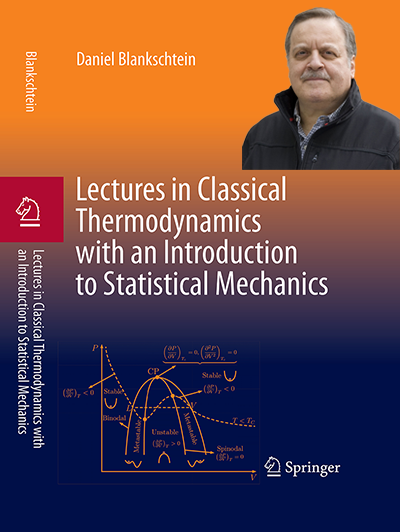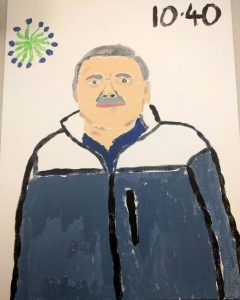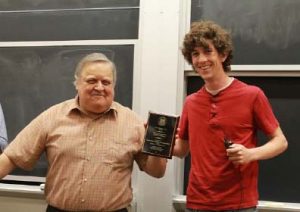 Daniel Blankschtein’s students have a wish coming true. The MIT professor of chemical engineering has written a long-awaited textbook based on lecture notes that he refined while teaching graduate-level thermodynamics 16 times over three decades.
Daniel Blankschtein’s students have a wish coming true. The MIT professor of chemical engineering has written a long-awaited textbook based on lecture notes that he refined while teaching graduate-level thermodynamics 16 times over three decades.
The book draws on existing classical thermodynamics texts, but brings something new to the table in the form of pedagogical explanations of the material taught with many practical problems and detailed solutions such as calculating how dangerous a bit of stray grease on a laboratory gas line can be, or determining how deep a submarine must submerge before the seawater is under enough pressure to produce fresh water inside the submarine from seawater.
Blankschtein, the Herman P. Meissner (1929) Professor of Chemical Engineering, began teaching in 1986, and has received the annual Course X Graduate Student Council Outstanding Faculty Award nine times.
The textbook, Lectures in Classical Thermodynamics with an Introduction to Statistical Mechanics, is being published by Springer and will be available in March 2021.
Blankschtein adapted his notes into a book because “the students were not happy with the available books where a pedagogical explanation of many fundamental concepts was lacking. The students also found my class notes easier to understand and used them to study for the course,” he said.
Students suggested that he adapt his notes to write a book, but following through on the suggestion was not easy. “For a long time I did not have time,” said Blankschtein. “To do this was a big effort. Although I had the notes, I had to refine them. I also had other activities that I was involved with.”
Research
One of the other activities was Blankschtein’s research. When he began his career at MIT his research involved predicting the properties of surfactants, molecules which reside between a polar material like water and a nonpolar material like oil that do not mix with each other. Surfactants can be used to facilitate mixing of oil and water, to encapsulate oil in order to clean up an oil spill in the sea, or to encapsulate oily fragrances in laundered fabrics to retain a pleasant aroma during storage.
Blankschtein’s surfactant research began by exploring the behavior of surfactants in bulk water where they form surfactant aggregates called micelles, and understanding their properties when they adsorb at the interfaces between water and air, water and oil, and water and a solid. “First, my group considered a single surfactant type in water, then we added salt, then we added two or more surfactant types to water, then we added polymers, and finally we added proteins,” said Blankschtein. Each addition was motivated by a practical application, he said. For example, in cosmetic products like shampoo, surfactants are used to clean the hair while polymers are used to control the viscosity of the shampoo as it flows out of the bottle.
A decade ago, Blankschtein began working with two-dimensional materials, which are only a single or few atoms thick. He worked with carbon nanotubes, which are microscopic rolled-up sheets of carbon atoms, and with graphene, molybdenum disulfide, and hexagonal boron nitride. Carbon nanotubes can be used as filtration agents, he said. “You can use them to separate ions to desalinate seawater. And we are also trying to separate gases using graphene that has small holes called nanopores.”
Blankschtein has also done theoretical and experimental work aimed at using ultrasound to temporarily open conduits in the skin so that drugs like insulin can be delivered through the skin rather than via injection. His theoretical modeling work identified the necessary conditions for the successful transdermal delivery of many drugs.
His most recent work is focused on elucidating the importance of many-body effects such as polarization interactions on the thermodynamic and transport properties of electrolytes at solid/water interfaces. This involves understanding and changing the energy landscape of molecules in the presence of electric fields. “You know, people have disregarded this for a long time,” he said. “If you put a solid (e.g., graphene) in contact with water it turns out that the water molecules, having a dipole moment, can polarize the charge distribution in the solid, and in turn, the solid can also polarize the water molecules. A similar thing also happens with charged species such as salt ions. This communication between the water and the salt ions with a polarizable material has not been recognized sufficiently and can have remarkable implications,” he said. “A dream would be that we can use it to desalinate water. But fundamental work of this nature will also find applications in other scientific disciplines, including electrochemistry, biophysics, and catalysis,” he said.
Blankschtein’s research has spawned 15 patents and more than 230 research articles, with his work providing new insights into multi-phase thermodynamics at the molecular level. No wonder that he wanted to include an introduction to statistical mechanics, which provides connections between microscopic and macroscopic phenomena, in his textbook. Typically, many textbooks on classical thermodynamics have not delved into the subject of statistical mechanics. However, “without fully understanding the working of the universe at the molecular level, you cannot develop a deep understanding of the universe at the macroscopic level,” he said.
Writing the book
Blankschtein waited until his research group got smaller, and then dedicated a sabbatical to the process of expanding and refining his lecture notes into the book that the students had requested. The book, which tops 750 pages, took about three years to complete.
Once he decided to write the book it was fairly steady progress, he said. A key takeaway from the process was to collect ideas for how to explain complex concepts pedagogically and to come up with problems even when there was no time to write. “If you think about a topic or problem, even if it is not fully mature, write it down so that you can get back to it,” he said.
The book consists of 50 lectures divided into three parts. The first two parts are on classical thermodynamics, which predicts what will happen at the macroscopic scale without going into details at the molecular level – “what you see with your eyes” said Blankschtein. Classical thermodynamics does not predict microscopic properties, but provides ways to relate macroscopic variables like energy, entropy, volume, pressure, temperature, and number of molecules. The connections between these variables are realized through the equations of state like the celebrated van der Waals equation of state, that have been developed over the past two centuries.
Students learn about single, non-reactive materials in the first part, titled “Fundamental Principles and Properties of Pure Fluids,” then move on to mixtures and physical/chemical transformations of materials in the second part, titled “Mixtures: Models and Applications to Phase and Chemical Reaction Equilibria.”
The third part of the book provides an introduction to statistical mechanics, which deals with phenomena at the microscopic level. “I show how some of the material that I discuss in the classical thermodynamics part of the book can be derived through statistical mechanics” said Blankschtein. For example, equations of state describe the relationships between pressure, volume, temperature, and number of molecules based on experimental results. On the other hand, the powerful tools of statistical mechanics enable students to derive those relationships directly at the molecular level.
The special sauce

The book shows the reader how to solve challenging problems in classical thermodynamics by applying fundamental principles in a series of solved problems that appear throughout the book, and in 35 additional challenging problems and solutions at the end of the book.
Blankschtein’s “special sauce” is these solved problems. He has included problems that are practical and easy to picture.
“Consider a problem which is very important in the lab,” said Blankschtein. Picture a chemical engineering lab with tanks of gases used for experiments, including oxygen tanks. The assignment is to comment on the safety hazards – what can happen when there is a bit of grease on the line of one of the oxygen tanks. And then to figure out, given the particular conditions laid out in the problem, whether this is something that you will have to worry about. “Can there be an explosion in this particular tank, which is very serious because this has really happened in laboratories,” Blankschtein said.
Blankschtein also included problems that guide students into figuring out how to produce freshwater in a submarine and useful work in a sailing ship.
The submarine problem features a creative chemical engineering graduate student trying his luck in the business world, said Blankschtein. The student can supplement his monthly stipend by inventing and patenting a novel scheme to produce freshwater for the crew of a nuclear submarine from the saltwater of the sea.
Blankschtein gives the students information about the seawater, including composition, mass density, and temperature. “I simplify it as sodium chloride, which is the salt that we use to salt the food that we eat, and I tell them to assume that the seawater is 100% disassociated into sodium (Na+) and chloride (Cl–) ions,” he said.
As the submarine descends into the sea, the pressure inside the submarine stays roughly the same while the pressure of the seawater outside the submarine increases. The question to be solved is how deep must the submarine descend before the pressure difference is enough to force fresh water into the submarine through a semipermeable membrane via reverse osmosis, thereby filtering out the salt ions to produce freshwater for the crew in the submarine.
The ship problem features a Carnot engine, which extracts heat from a heat source and releases heat to a cold source, and in the process produces useful mechanical work. As a ship is sailing “there is a warm stream and a cold stream that the ship is moving between,” said Blankschtein. “The question is can you extract some useful work out of these hot and cold streams,” he said.
After the students gain a good understanding of classical thermodynamics, they learn statistical mechanics at an introductory albeit deep level, where they can understand and relate what happens at the microscopic level to the thermodynamic behavior which is observed at the macroscopic level.
The book has plenty of solved examples in that part as well, said Blankschtein.
One problem takes students through how to calculate how much of a given volume of gas in a container will be adsorbed onto the walls of the container at a certain temperature and pressure. The answer also depends on the energy required for a gas molecule to adsorb onto the wall. “You want to know how much gas is adsorbed to figure out how much gas remains in the container,” said Blankschtein.
Other problems relate to biological systems, including calculating how many ligands can bind to a given protein or showing how a given protein will unfold at a given temperature.
Teaching

Blankschtein said that he always spends a lot of time preparing, even after teaching a course several times. “I still try to improve what I teach. I try to find different ways to explain a concept, and I believe that this goal is reflected in the book,” he said. “The most fun for me, frankly, has always been teaching – teaching students and mentoring them.”
Most of his teaching has been to graduate students, but the blue egg demonstration that he used in an undergraduate thermodynamics course to introduce osmotic pressure is something students that he encounters years later still remember, he said. At that time, he soaked an egg in vinegar to dissolve the calcium shell, weighed the egg, still held together by its sturdy membrane, then dipped the egg in water colored with a blue dye and weighed it again to see how much dye was absorbed through the membrane.
The book is not the first time that Blankschtein has taken on a project aimed at making it easier for scholars and industrial practitioners to grasp the theories behind chemical engineering.
In addition to theoretical research, his group has created computer programs to predict surfactant properties in bulk solution and at interfaces that make it possible for non-theoreticians to use the theories that his group has developed. “For example, users input the structure of a surfactant, the temperature, and the salt type and concentration, and they press a button, and the computer program outputs many different desired surfactant properties,” Blankschtein said. Several companies are currently using his computer programs to facilitate design of new surfactant-containing products, including laundry detergents, cosmetic lotions, and household cleaning products.
Blankschtein hopes that students, teachers , and researchers will find his book illuminating and useful.
Read more:
DB Group @ MIT ChemE, Research in Colloid and Interface Science
MIT News:
– Daniel Blankschtein honored with McDonald Mentoring Award
– Researchers catalog defects that give 2-D materials amazing properties

